Analyzing the Impact of Transitions for Children with Needs
VerifiedAdded on 2023/06/03
|12
|1246
|231
Essay
AI Summary
This essay examines the impact of effective transitions on children with additional educational needs and their families. It highlights the challenges these children face when transitioning in school, emphasizing the importance of support systems for smooth learning and inclusion. The essay discusses frameworks and practices that foster effective transition, including student-focused planning, learner development, interdisciplinary collaboration, and consideration of the family. It also identifies intellectual, learning, physical, and social factors affecting successful transition. The essay concludes with recommendations for creating inclusive environments, adopting outcome-based pedagogical procedures, and embracing child-centered frameworks to support the development of task-related behaviors and conduct for effective transition. Desklib offers a range of resources, including past papers and solved assignments, to aid students in their academic pursuits.
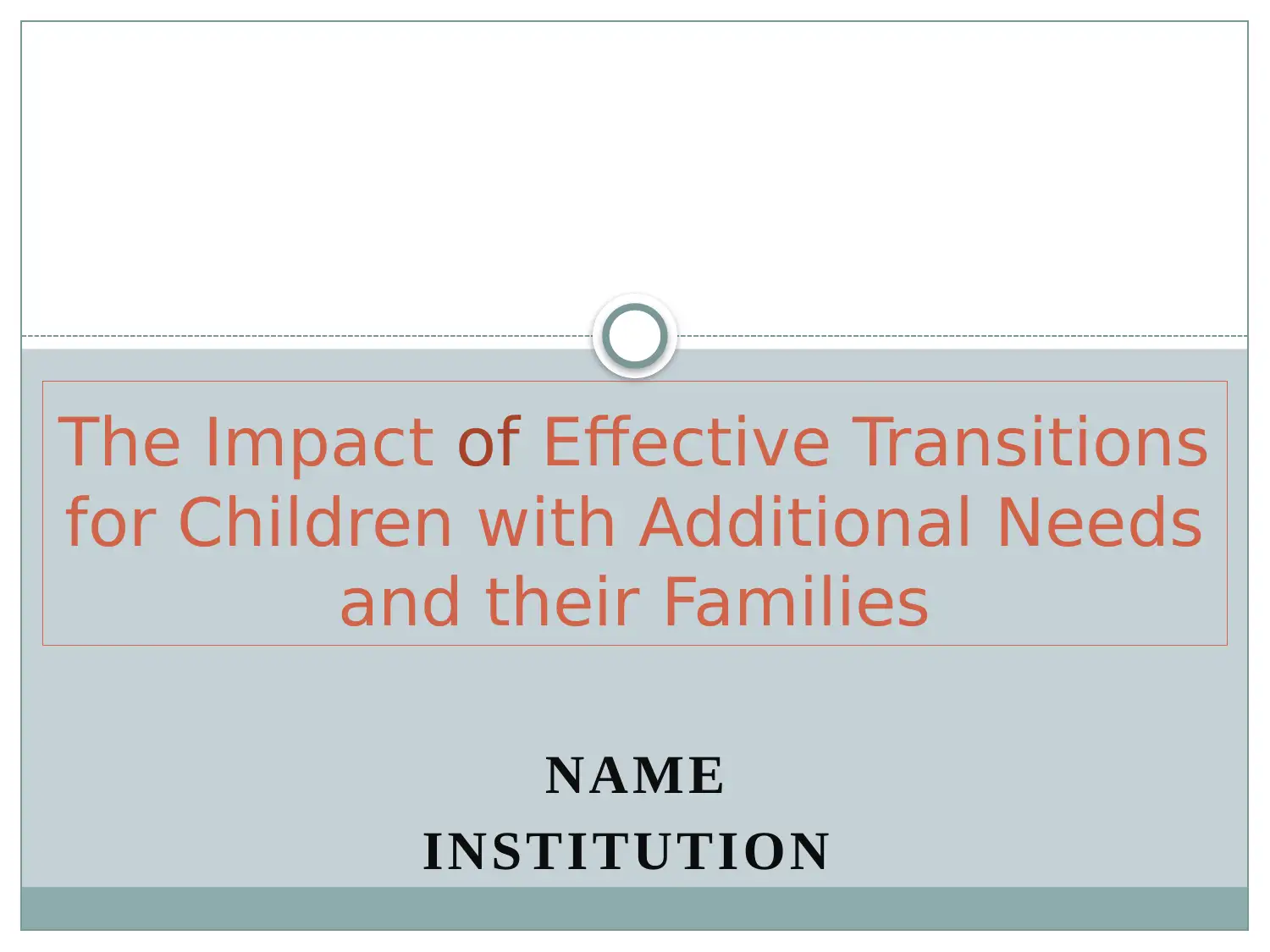
NAME
INSTITUTION
The Impact of Effective Transitions
for Children with Additional Needs
and their Families
INSTITUTION
The Impact of Effective Transitions
for Children with Additional Needs
and their Families
Paraphrase This Document
Need a fresh take? Get an instant paraphrase of this document with our AI Paraphraser
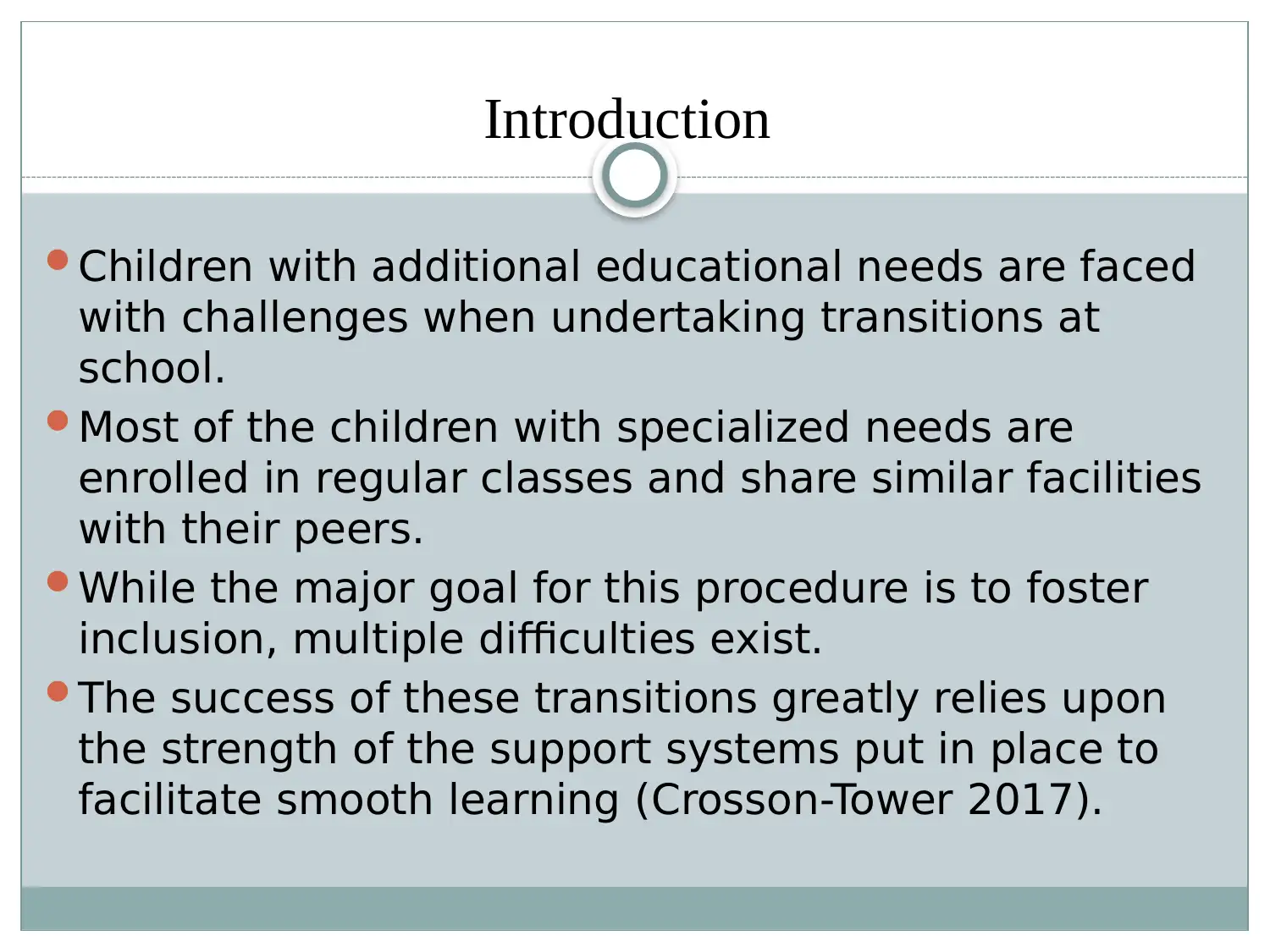
Introduction
Children with additional educational needs are faced
with challenges when undertaking transitions at
school.
Most of the children with specialized needs are
enrolled in regular classes and share similar facilities
with their peers.
While the major goal for this procedure is to foster
inclusion, multiple difficulties exist.
The success of these transitions greatly relies upon
the strength of the support systems put in place to
facilitate smooth learning (Crosson-Tower 2017).
Children with additional educational needs are faced
with challenges when undertaking transitions at
school.
Most of the children with specialized needs are
enrolled in regular classes and share similar facilities
with their peers.
While the major goal for this procedure is to foster
inclusion, multiple difficulties exist.
The success of these transitions greatly relies upon
the strength of the support systems put in place to
facilitate smooth learning (Crosson-Tower 2017).
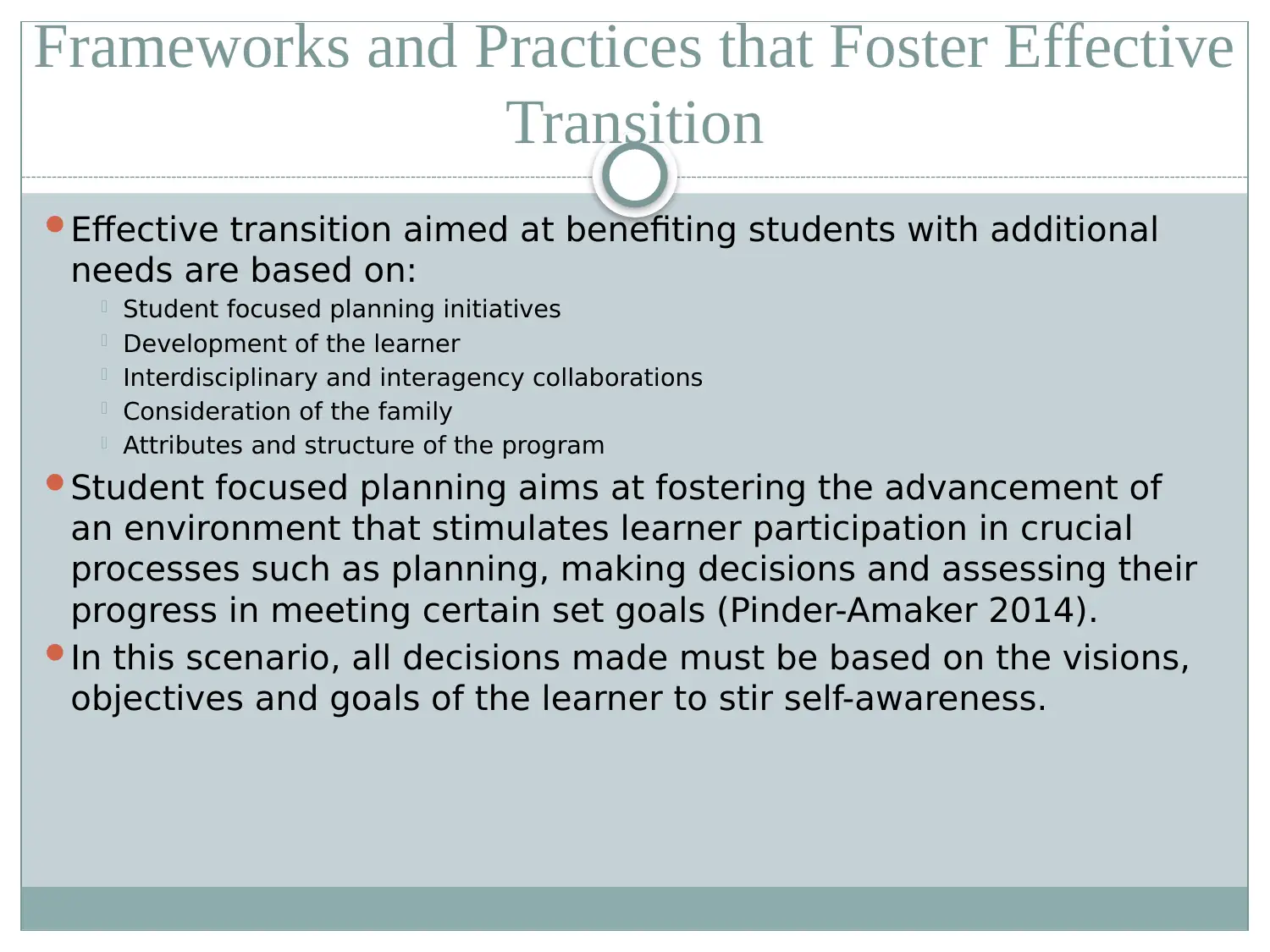
Frameworks and Practices that Foster Effective
Transition
Effective transition aimed at benefiting students with additional
needs are based on:
Student focused planning initiatives
Development of the learner
Interdisciplinary and interagency collaborations
Consideration of the family
Attributes and structure of the program
Student focused planning aims at fostering the advancement of
an environment that stimulates learner participation in crucial
processes such as planning, making decisions and assessing their
progress in meeting certain set goals (Pinder-Amaker 2014).
In this scenario, all decisions made must be based on the visions,
objectives and goals of the learner to stir self-awareness.
Transition
Effective transition aimed at benefiting students with additional
needs are based on:
Student focused planning initiatives
Development of the learner
Interdisciplinary and interagency collaborations
Consideration of the family
Attributes and structure of the program
Student focused planning aims at fostering the advancement of
an environment that stimulates learner participation in crucial
processes such as planning, making decisions and assessing their
progress in meeting certain set goals (Pinder-Amaker 2014).
In this scenario, all decisions made must be based on the visions,
objectives and goals of the learner to stir self-awareness.
⊘ This is a preview!⊘
Do you want full access?
Subscribe today to unlock all pages.

Trusted by 1+ million students worldwide
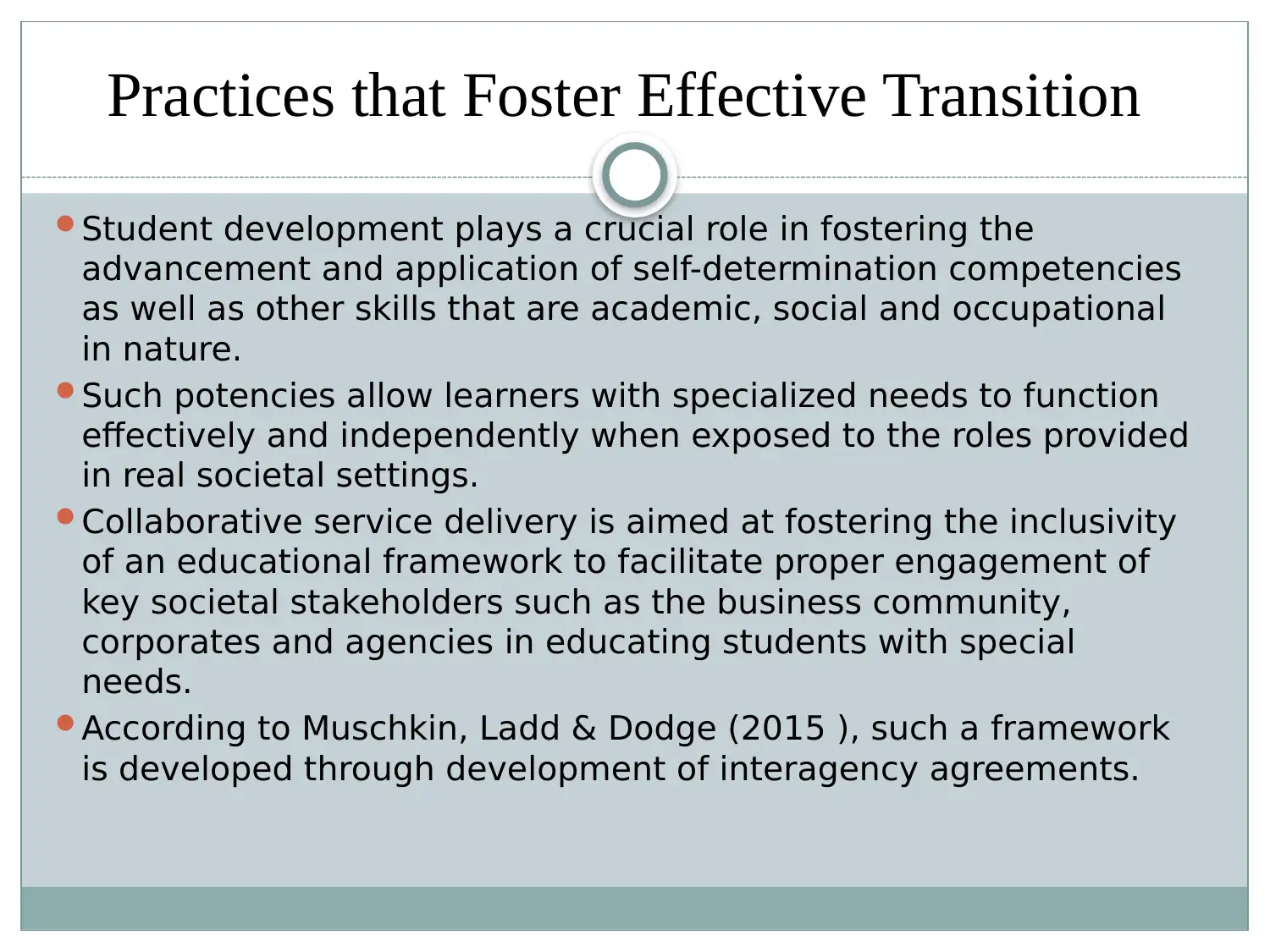
Practices that Foster Effective Transition
Student development plays a crucial role in fostering the
advancement and application of self-determination competencies
as well as other skills that are academic, social and occupational
in nature.
Such potencies allow learners with specialized needs to function
effectively and independently when exposed to the roles provided
in real societal settings.
Collaborative service delivery is aimed at fostering the inclusivity
of an educational framework to facilitate proper engagement of
key societal stakeholders such as the business community,
corporates and agencies in educating students with special
needs.
According to Muschkin, Ladd & Dodge (2015 ), such a framework
is developed through development of interagency agreements.
Student development plays a crucial role in fostering the
advancement and application of self-determination competencies
as well as other skills that are academic, social and occupational
in nature.
Such potencies allow learners with specialized needs to function
effectively and independently when exposed to the roles provided
in real societal settings.
Collaborative service delivery is aimed at fostering the inclusivity
of an educational framework to facilitate proper engagement of
key societal stakeholders such as the business community,
corporates and agencies in educating students with special
needs.
According to Muschkin, Ladd & Dodge (2015 ), such a framework
is developed through development of interagency agreements.
Paraphrase This Document
Need a fresh take? Get an instant paraphrase of this document with our AI Paraphraser
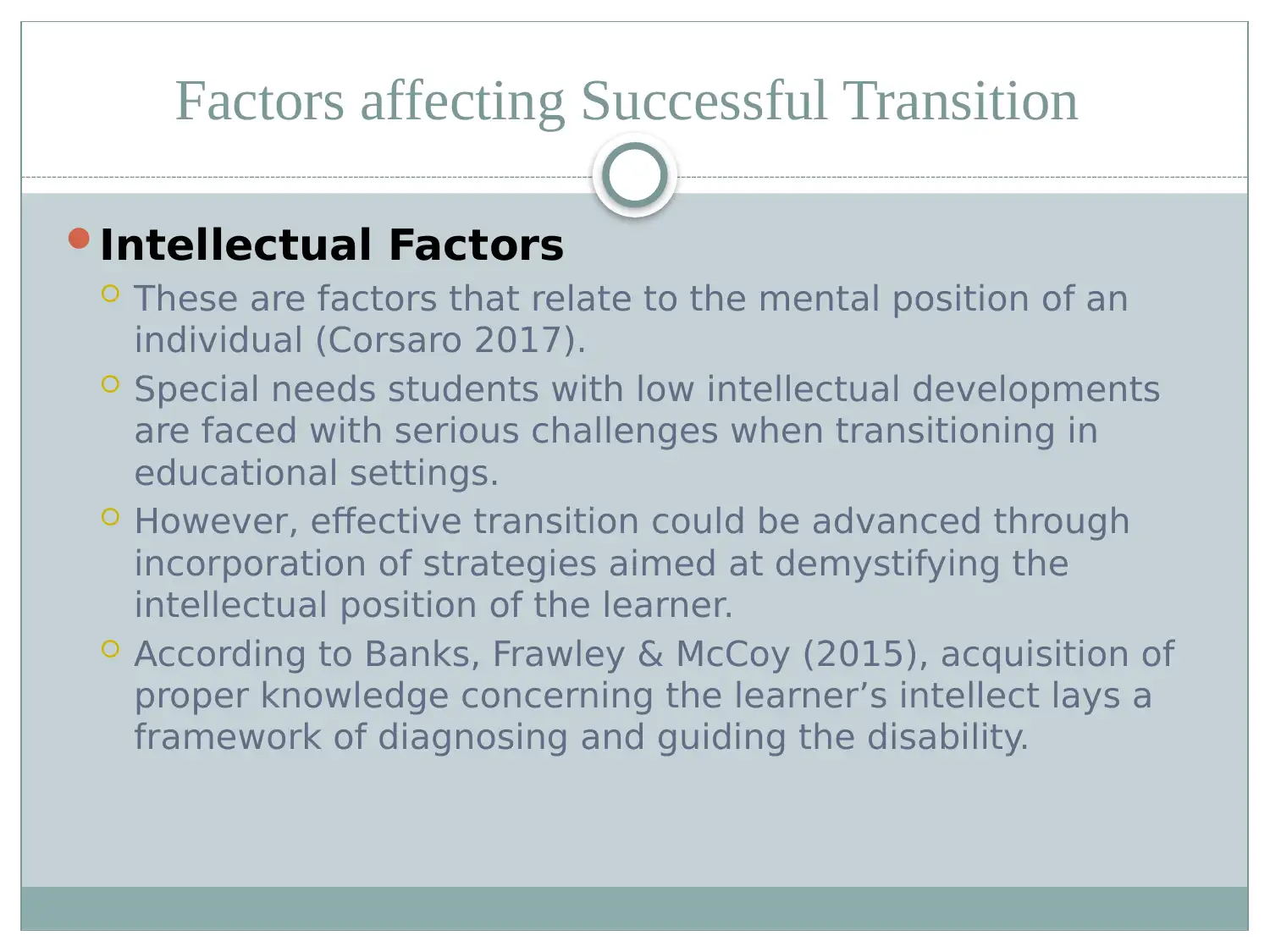
Factors affecting Successful Transition
Intellectual Factors
These are factors that relate to the mental position of an
individual (Corsaro 2017).
Special needs students with low intellectual developments
are faced with serious challenges when transitioning in
educational settings.
However, effective transition could be advanced through
incorporation of strategies aimed at demystifying the
intellectual position of the learner.
According to Banks, Frawley & McCoy (2015), acquisition of
proper knowledge concerning the learner’s intellect lays a
framework of diagnosing and guiding the disability.
Intellectual Factors
These are factors that relate to the mental position of an
individual (Corsaro 2017).
Special needs students with low intellectual developments
are faced with serious challenges when transitioning in
educational settings.
However, effective transition could be advanced through
incorporation of strategies aimed at demystifying the
intellectual position of the learner.
According to Banks, Frawley & McCoy (2015), acquisition of
proper knowledge concerning the learner’s intellect lays a
framework of diagnosing and guiding the disability.
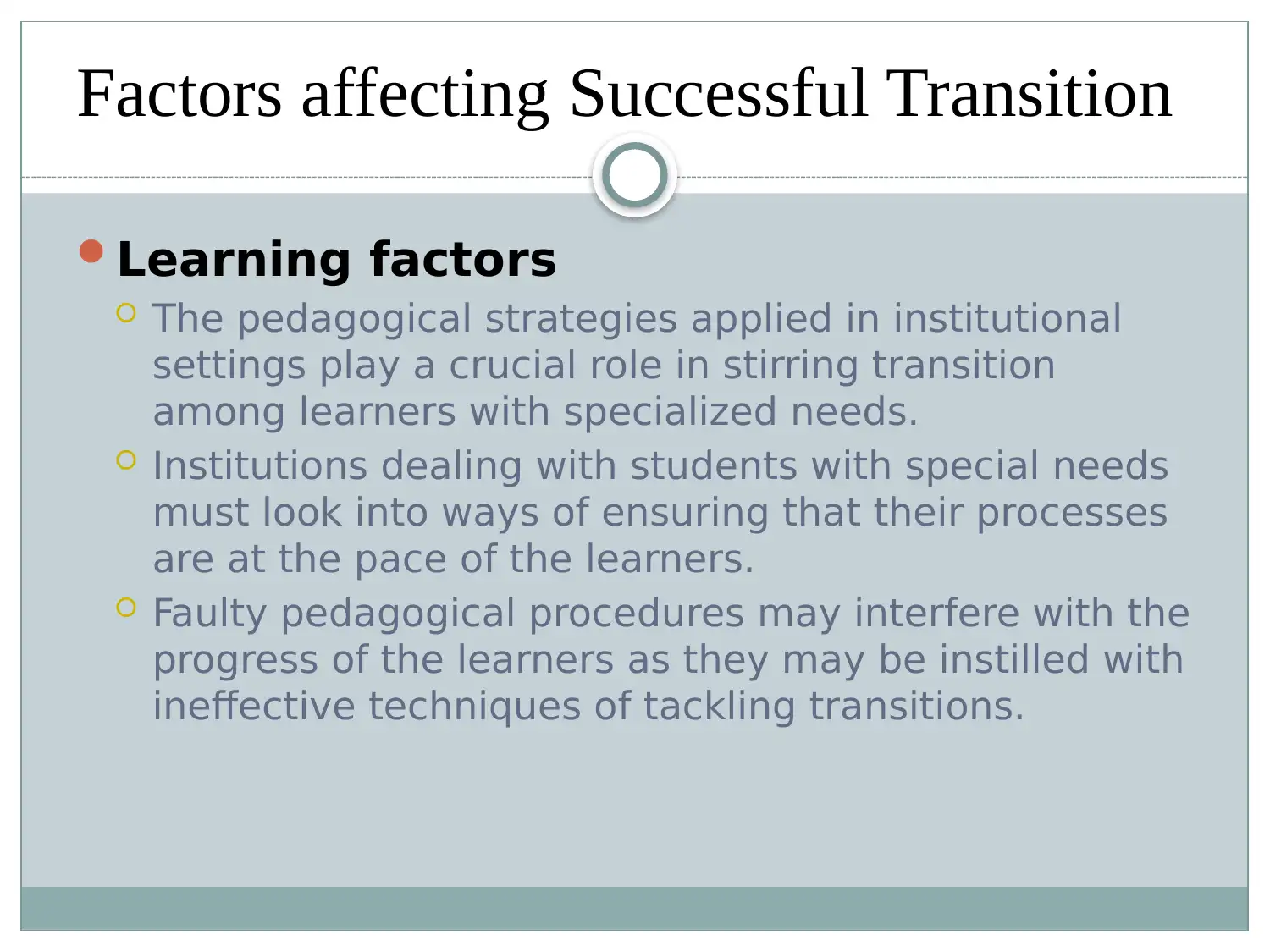
Factors affecting Successful Transition
Learning factors
The pedagogical strategies applied in institutional
settings play a crucial role in stirring transition
among learners with specialized needs.
Institutions dealing with students with special needs
must look into ways of ensuring that their processes
are at the pace of the learners.
Faulty pedagogical procedures may interfere with the
progress of the learners as they may be instilled with
ineffective techniques of tackling transitions.
Learning factors
The pedagogical strategies applied in institutional
settings play a crucial role in stirring transition
among learners with specialized needs.
Institutions dealing with students with special needs
must look into ways of ensuring that their processes
are at the pace of the learners.
Faulty pedagogical procedures may interfere with the
progress of the learners as they may be instilled with
ineffective techniques of tackling transitions.
⊘ This is a preview!⊘
Do you want full access?
Subscribe today to unlock all pages.

Trusted by 1+ million students worldwide
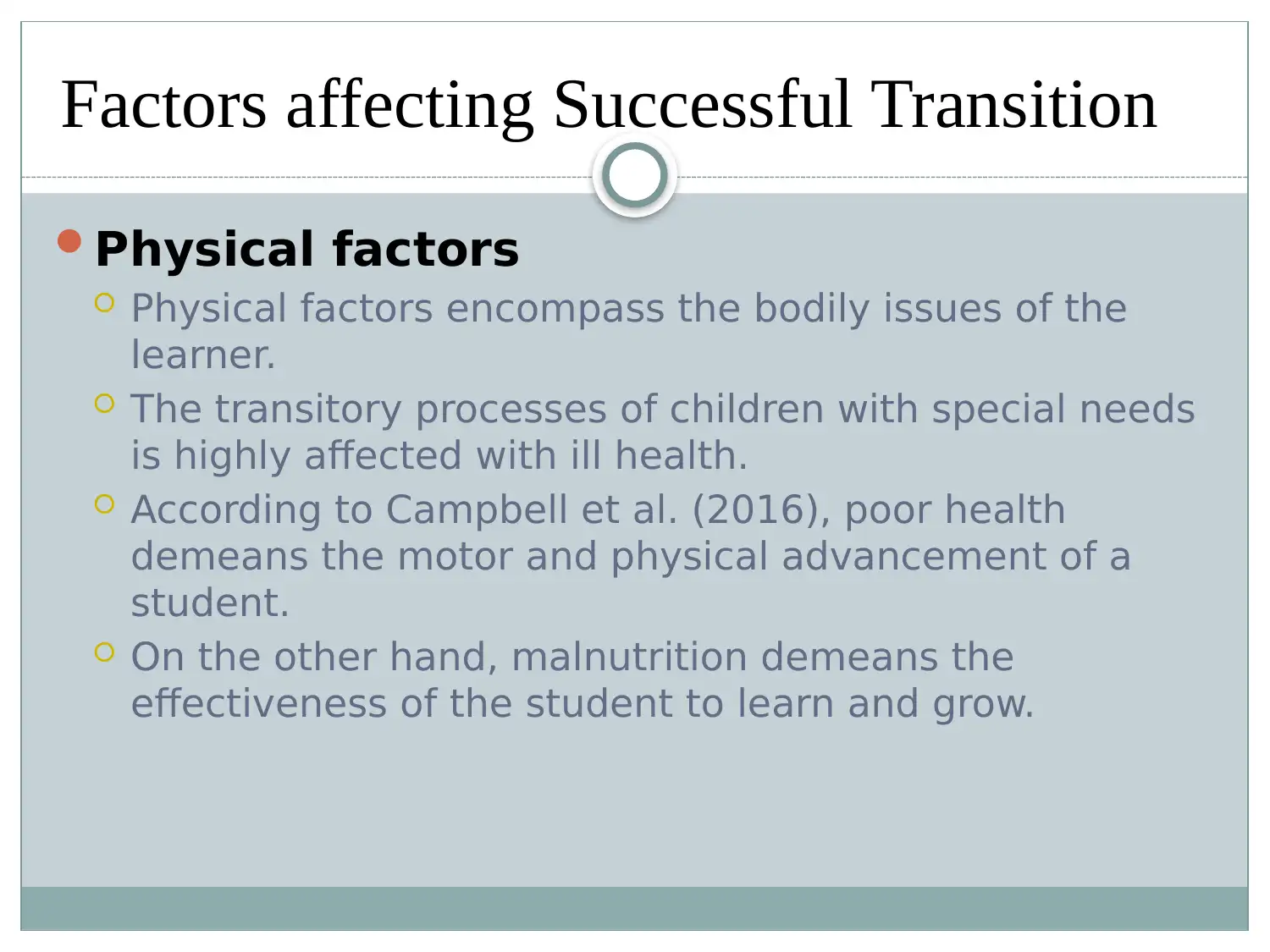
Factors affecting Successful Transition
Physical factors
Physical factors encompass the bodily issues of the
learner.
The transitory processes of children with special needs
is highly affected with ill health.
According to Campbell et al. (2016), poor health
demeans the motor and physical advancement of a
student.
On the other hand, malnutrition demeans the
effectiveness of the student to learn and grow.
Physical factors
Physical factors encompass the bodily issues of the
learner.
The transitory processes of children with special needs
is highly affected with ill health.
According to Campbell et al. (2016), poor health
demeans the motor and physical advancement of a
student.
On the other hand, malnutrition demeans the
effectiveness of the student to learn and grow.
Paraphrase This Document
Need a fresh take? Get an instant paraphrase of this document with our AI Paraphraser
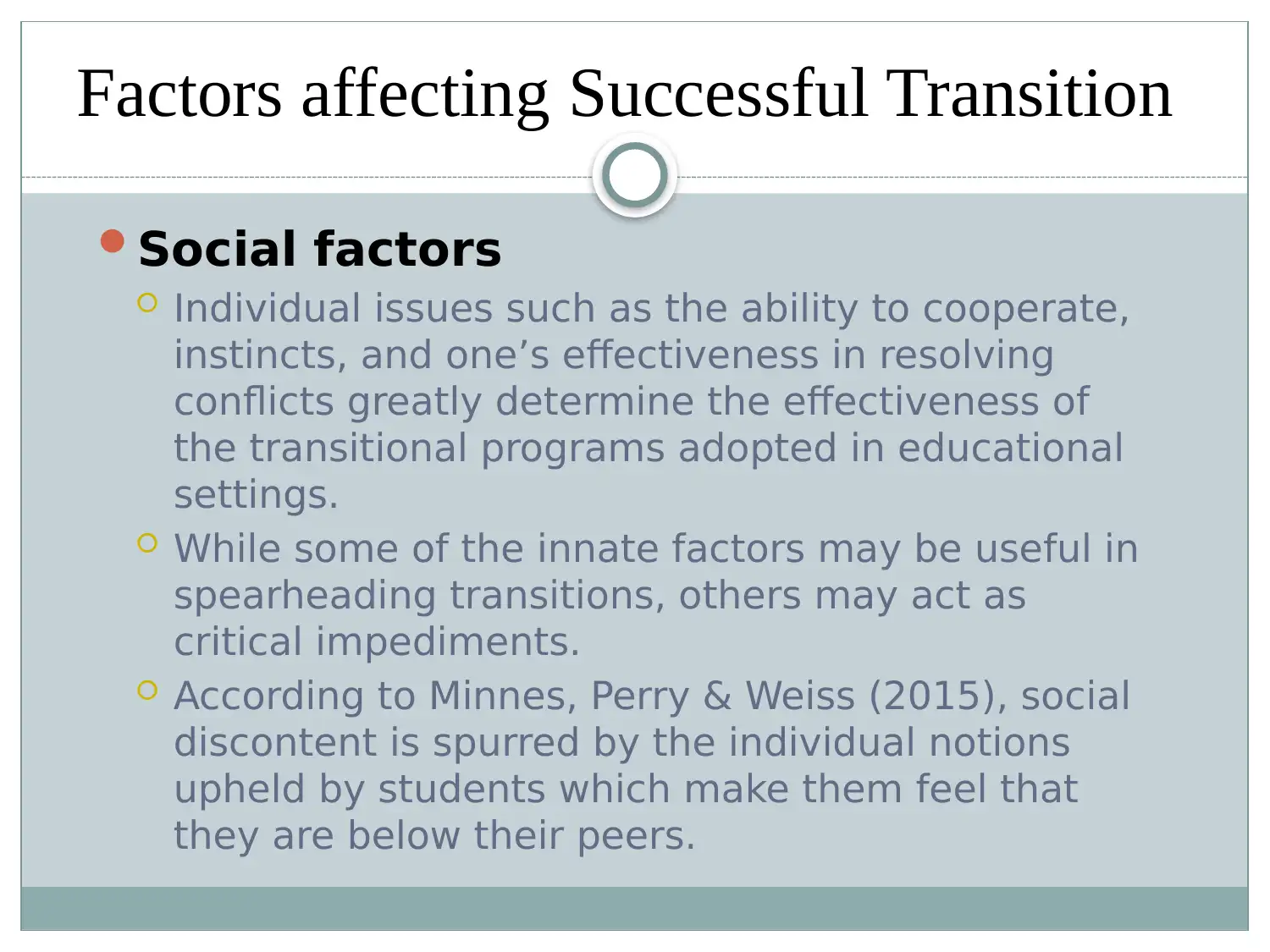
Factors affecting Successful Transition
Social factors
Individual issues such as the ability to cooperate,
instincts, and one’s effectiveness in resolving
conflicts greatly determine the effectiveness of
the transitional programs adopted in educational
settings.
While some of the innate factors may be useful in
spearheading transitions, others may act as
critical impediments.
According to Minnes, Perry & Weiss (2015), social
discontent is spurred by the individual notions
upheld by students which make them feel that
they are below their peers.
Social factors
Individual issues such as the ability to cooperate,
instincts, and one’s effectiveness in resolving
conflicts greatly determine the effectiveness of
the transitional programs adopted in educational
settings.
While some of the innate factors may be useful in
spearheading transitions, others may act as
critical impediments.
According to Minnes, Perry & Weiss (2015), social
discontent is spurred by the individual notions
upheld by students which make them feel that
they are below their peers.
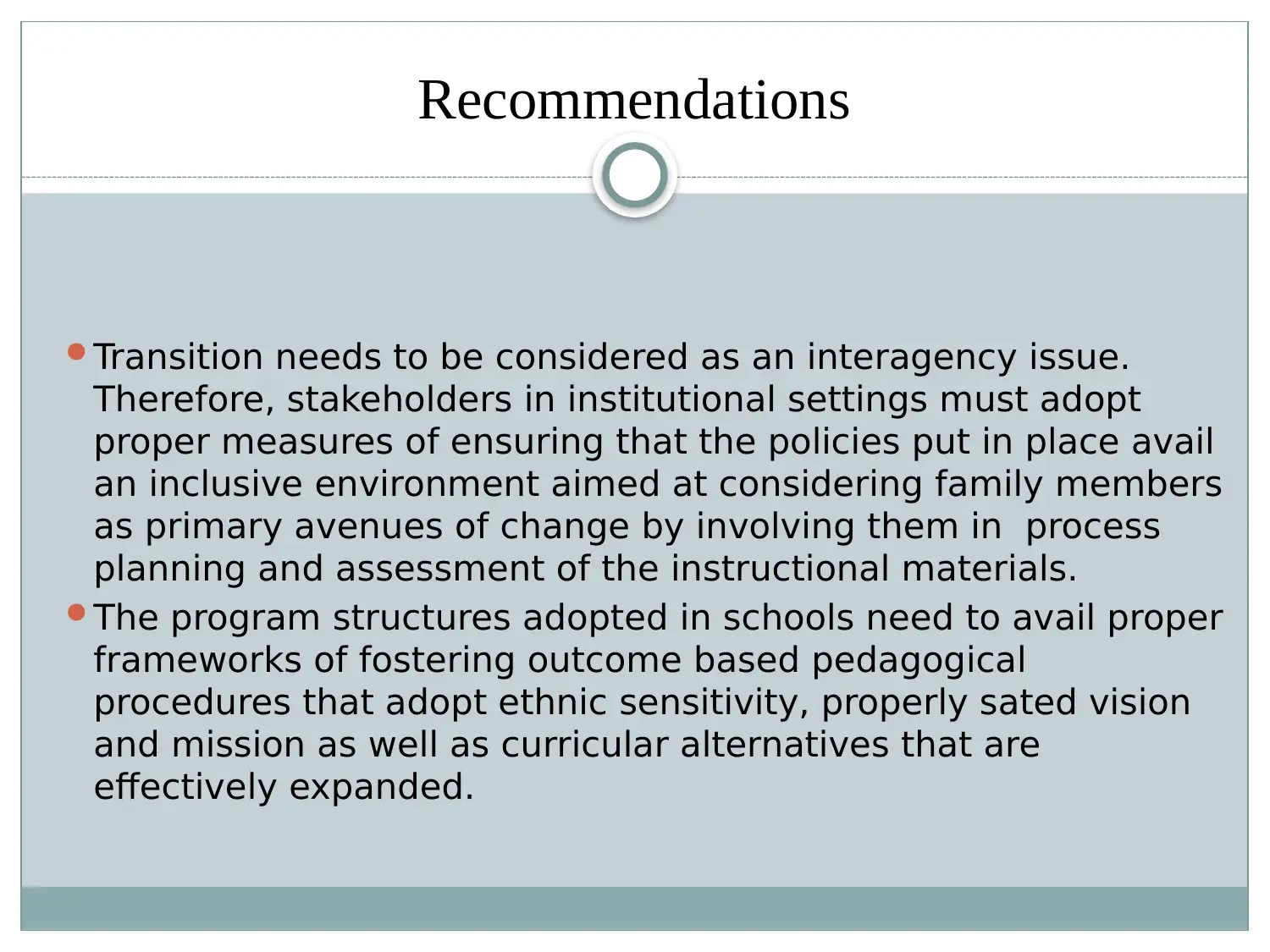
Recommendations
Transition needs to be considered as an interagency issue.
Therefore, stakeholders in institutional settings must adopt
proper measures of ensuring that the policies put in place avail
an inclusive environment aimed at considering family members
as primary avenues of change by involving them in process
planning and assessment of the instructional materials.
The program structures adopted in schools need to avail proper
frameworks of fostering outcome based pedagogical
procedures that adopt ethnic sensitivity, properly sated vision
and mission as well as curricular alternatives that are
effectively expanded.
Transition needs to be considered as an interagency issue.
Therefore, stakeholders in institutional settings must adopt
proper measures of ensuring that the policies put in place avail
an inclusive environment aimed at considering family members
as primary avenues of change by involving them in process
planning and assessment of the instructional materials.
The program structures adopted in schools need to avail proper
frameworks of fostering outcome based pedagogical
procedures that adopt ethnic sensitivity, properly sated vision
and mission as well as curricular alternatives that are
effectively expanded.
⊘ This is a preview!⊘
Do you want full access?
Subscribe today to unlock all pages.

Trusted by 1+ million students worldwide
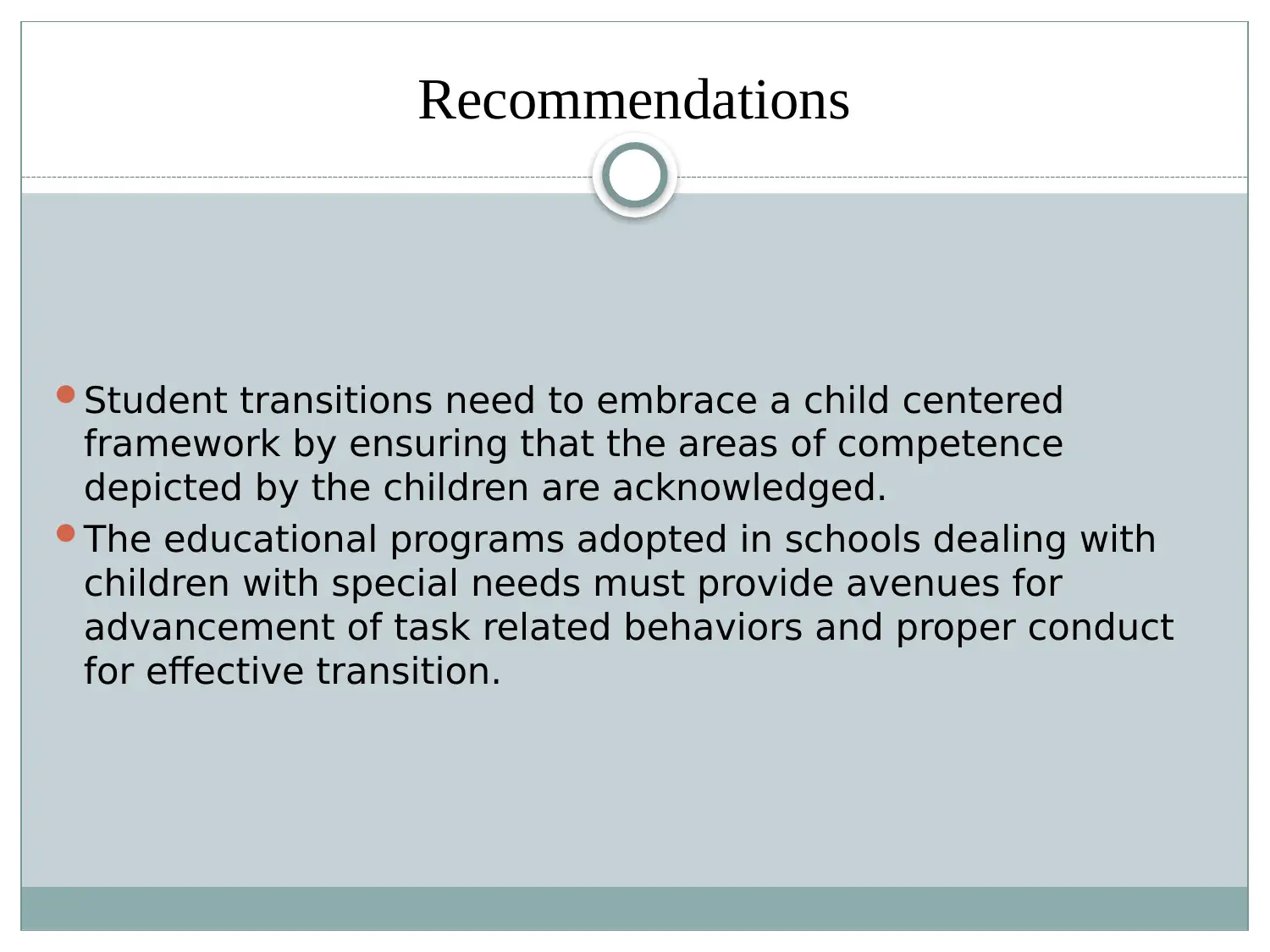
Recommendations
Student transitions need to embrace a child centered
framework by ensuring that the areas of competence
depicted by the children are acknowledged.
The educational programs adopted in schools dealing with
children with special needs must provide avenues for
advancement of task related behaviors and proper conduct
for effective transition.
Student transitions need to embrace a child centered
framework by ensuring that the areas of competence
depicted by the children are acknowledged.
The educational programs adopted in schools dealing with
children with special needs must provide avenues for
advancement of task related behaviors and proper conduct
for effective transition.
Paraphrase This Document
Need a fresh take? Get an instant paraphrase of this document with our AI Paraphraser
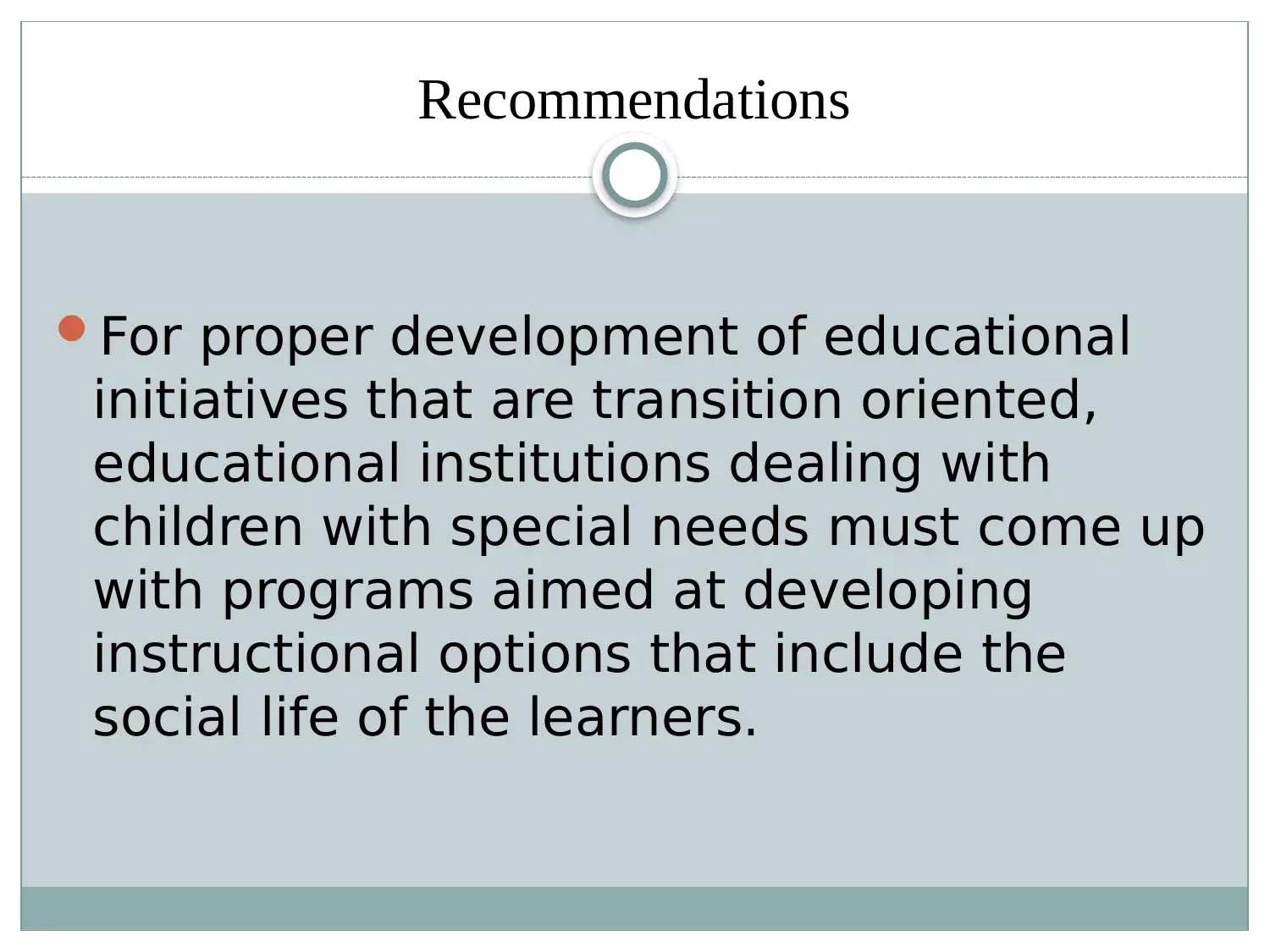
Recommendations
For proper development of educational
initiatives that are transition oriented,
educational institutions dealing with
children with special needs must come up
with programs aimed at developing
instructional options that include the
social life of the learners.
For proper development of educational
initiatives that are transition oriented,
educational institutions dealing with
children with special needs must come up
with programs aimed at developing
instructional options that include the
social life of the learners.
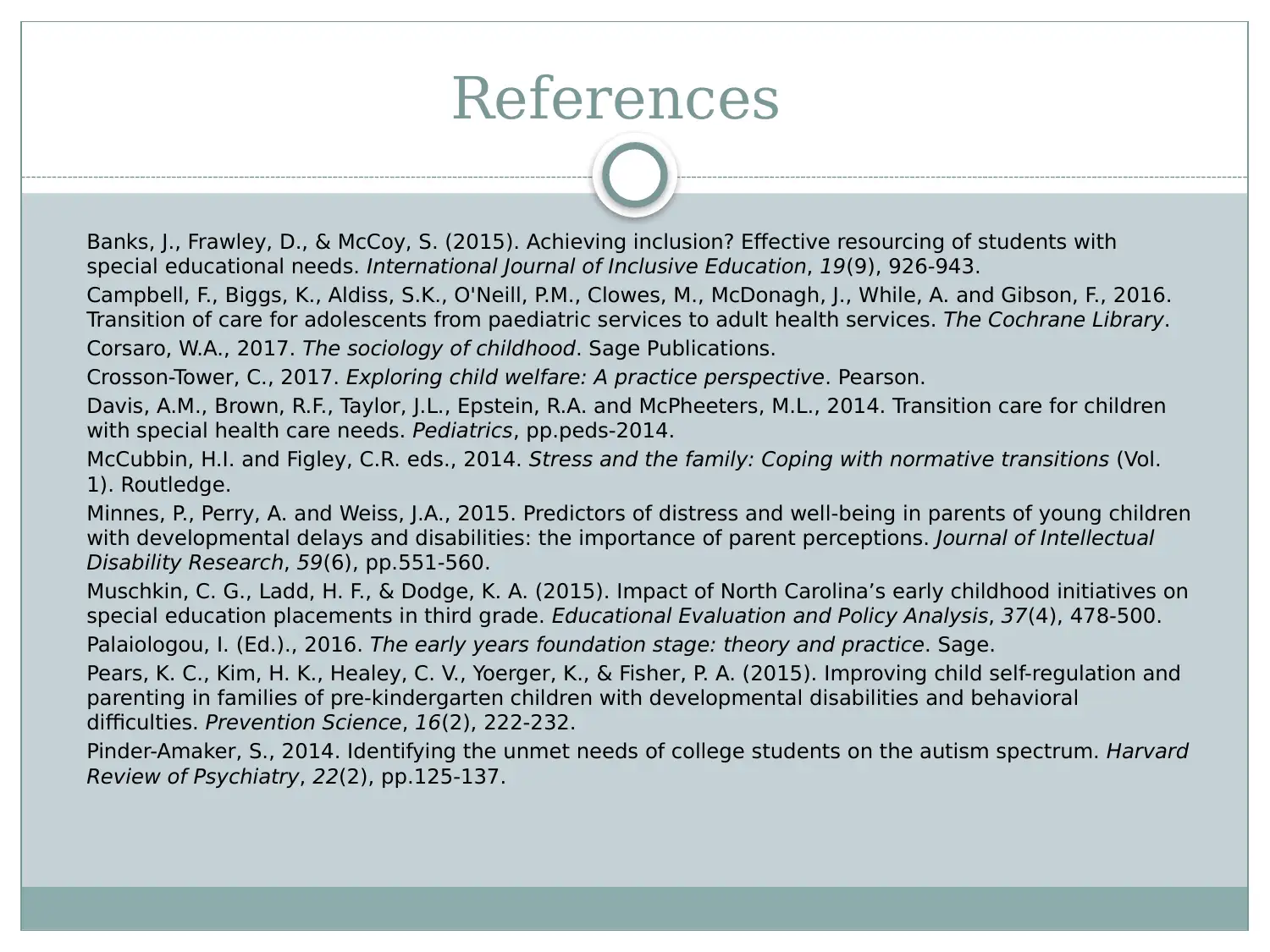
References
Banks, J., Frawley, D., & McCoy, S. (2015). Achieving inclusion? Effective resourcing of students with
special educational needs. International Journal of Inclusive Education, 19(9), 926-943.
Campbell, F., Biggs, K., Aldiss, S.K., O'Neill, P.M., Clowes, M., McDonagh, J., While, A. and Gibson, F., 2016.
Transition of care for adolescents from paediatric services to adult health services. The Cochrane Library.
Corsaro, W.A., 2017. The sociology of childhood. Sage Publications.
Crosson-Tower, C., 2017. Exploring child welfare: A practice perspective. Pearson.
Davis, A.M., Brown, R.F., Taylor, J.L., Epstein, R.A. and McPheeters, M.L., 2014. Transition care for children
with special health care needs. Pediatrics, pp.peds-2014.
McCubbin, H.I. and Figley, C.R. eds., 2014. Stress and the family: Coping with normative transitions (Vol.
1). Routledge.
Minnes, P., Perry, A. and Weiss, J.A., 2015. Predictors of distress and well‐being in parents of young children
with developmental delays and disabilities: the importance of parent perceptions. Journal of Intellectual
Disability Research, 59(6), pp.551-560.
Muschkin, C. G., Ladd, H. F., & Dodge, K. A. (2015). Impact of North Carolina’s early childhood initiatives on
special education placements in third grade. Educational Evaluation and Policy Analysis, 37(4), 478-500.
Palaiologou, I. (Ed.)., 2016. The early years foundation stage: theory and practice. Sage.
Pears, K. C., Kim, H. K., Healey, C. V., Yoerger, K., & Fisher, P. A. (2015). Improving child self-regulation and
parenting in families of pre-kindergarten children with developmental disabilities and behavioral
difficulties. Prevention Science, 16(2), 222-232.
Pinder-Amaker, S., 2014. Identifying the unmet needs of college students on the autism spectrum. Harvard
Review of Psychiatry, 22(2), pp.125-137.
Banks, J., Frawley, D., & McCoy, S. (2015). Achieving inclusion? Effective resourcing of students with
special educational needs. International Journal of Inclusive Education, 19(9), 926-943.
Campbell, F., Biggs, K., Aldiss, S.K., O'Neill, P.M., Clowes, M., McDonagh, J., While, A. and Gibson, F., 2016.
Transition of care for adolescents from paediatric services to adult health services. The Cochrane Library.
Corsaro, W.A., 2017. The sociology of childhood. Sage Publications.
Crosson-Tower, C., 2017. Exploring child welfare: A practice perspective. Pearson.
Davis, A.M., Brown, R.F., Taylor, J.L., Epstein, R.A. and McPheeters, M.L., 2014. Transition care for children
with special health care needs. Pediatrics, pp.peds-2014.
McCubbin, H.I. and Figley, C.R. eds., 2014. Stress and the family: Coping with normative transitions (Vol.
1). Routledge.
Minnes, P., Perry, A. and Weiss, J.A., 2015. Predictors of distress and well‐being in parents of young children
with developmental delays and disabilities: the importance of parent perceptions. Journal of Intellectual
Disability Research, 59(6), pp.551-560.
Muschkin, C. G., Ladd, H. F., & Dodge, K. A. (2015). Impact of North Carolina’s early childhood initiatives on
special education placements in third grade. Educational Evaluation and Policy Analysis, 37(4), 478-500.
Palaiologou, I. (Ed.)., 2016. The early years foundation stage: theory and practice. Sage.
Pears, K. C., Kim, H. K., Healey, C. V., Yoerger, K., & Fisher, P. A. (2015). Improving child self-regulation and
parenting in families of pre-kindergarten children with developmental disabilities and behavioral
difficulties. Prevention Science, 16(2), 222-232.
Pinder-Amaker, S., 2014. Identifying the unmet needs of college students on the autism spectrum. Harvard
Review of Psychiatry, 22(2), pp.125-137.
⊘ This is a preview!⊘
Do you want full access?
Subscribe today to unlock all pages.

Trusted by 1+ million students worldwide
1 out of 12
Related Documents
Your All-in-One AI-Powered Toolkit for Academic Success.
+13062052269
info@desklib.com
Available 24*7 on WhatsApp / Email
![[object Object]](/_next/static/media/star-bottom.7253800d.svg)
Unlock your academic potential
Copyright © 2020–2025 A2Z Services. All Rights Reserved. Developed and managed by ZUCOL.





